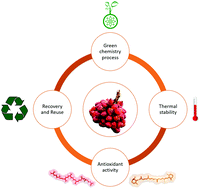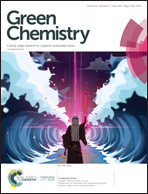Ionic liquid-high performance extractive approach to recover carotenoids from Bactris gasipaes fruits†
Abstract
Nowadays, one of the biggest challenges for society is the development of appropriate technologies to process the waste residue produced worldwide. In the food sector, the generated waste is estimated to be nearly billions of tons annually. Brazil is one of the most representative examples of the economic and industrial potential of underexplored residues and raw materials. The palm heart, scientifically known as Bactris gasipaes, mainly its fruits, is one of the many examples found in Brazilian flora. The fruits have significant amounts of carotenoids, namely, the all-trans-β-carotene, all-trans-lycopene and the rare all-trans-γ-carotene, which are considered as excellent raw materials of commercial interest. However, the main challenge that remains is their efficient recovery. This work proposes the development of a performant process of extraction mediated by the use of ionic liquid (IL)-based ethanolic solutions. Four ILs were examined, as well as the solid–liquid ratio R(S/L), number of extractions, the time of extraction, the co-solvent-ratio R(IL/E) and the homogenization method employed. After selecting the best solvent ([C4mim][BF4]) and process conditions (extraction yield of 172 ± 18 μgcarotenoids gdried biomass−1), the IL-ethanolic solution recyclability was tested by freezing/precipitating the IL (maximum of 94% of IL recovered), proving its success for at least 10 cycles while decreasing the process carbon footprint by 50% compared with the conventional method using acetone.



 Please wait while we load your content...
Please wait while we load your content...